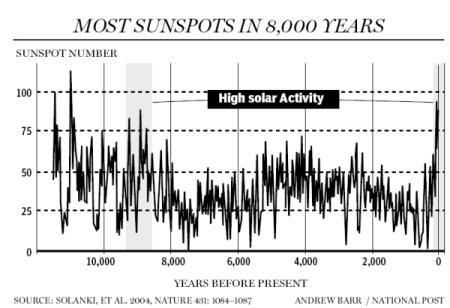Sunspot Cause Global Warming
Greenies… Please Read!
I wanted to post the entire article that the DRUDGE REPORT linked to because it is an important read… especially for the two teachers that may grace my site. It is long and semi-technical… but well worth the read.
Keep in mind that these scientists who have found the link between sunspots and our climate are also getting “predictful” in their assessment, but at least they are more grounded than the eco-fascists of the Left. These predictions should be taken with a grain of salt. But this is the difference between their predictions and those of the Left: there is nothing we can do to curb these fluctuations.
So, no legislation, taxes, corporate restrictions, and the like should come from their findings. It is a natural condition of both our solar system and the universe. I do want to point out though that we have made a complete circle from the first Earth Day in 1970, which preached a catastrophic “global cooling” to a more recent phenomenon of “global warming,” to again a less catastrophic global cooling. (I put two of the “globals” in parenthesis because they are the ones being used by extremist groups to have legislation enacted. The third is merely the best statement cosmologists can give with no political input whatsoever.)
I will make a prediction now though: the Left and the U.N. will not change the course they are on because it is handing too much money and power over to the people who are… well… the Bumper Sticker below explains:
(I did embolden/emphasis a few key points)
Read the Sunspots
The mud at the bottom of B.C. fjords reveals that solar output drives climate change - and that we should prepare now for dangerous global cooling
R. Timothy Patterson
Financial Post
Wednesday, June 20, 2007
(R. Timothy Patterson is professor and director of the Ottawa-Carleton Geoscience Centre, Department of Earth Sciences,
Politicians and environmentalists these days convey the impression that climate-change research is an exceptionally dull field with little left to discover. We are assured by everyone from David Suzuki to Al Gore to Prime Minister Stephen Harper that "the science is settled." At the recent G8 summit, German Chancellor Angela Merkel even attempted to convince world leaders to play God by restricting carbon-dioxide emissions to a level that would magically limit the rise in world temperatures to 2C.
The fact that science is many years away from properly understanding global climate doesn't seem to bother our leaders at all. Inviting testimony only from those who don't question political orthodoxy on the issue, parliamentarians are charging ahead with the impossible and expensive goal of "stopping global climate change." Liberal MP Ralph Goodale's June 11 House of Commons assertion that Parliament should have "a real good discussion about the potential for carbon capture and sequestration in dealing with carbon dioxide, which has tremendous potential for improving the climate, not only here in Canada but around the world," would be humorous were he, and even the current government, not deadly serious about devoting vast resources to this hopeless crusade.
Climate stability has never been a feature of planet Earth. The only constant about climate is change; it changes continually and, at times, quite rapidly. Many times in the past, temperatures were far higher than today, and occasionally, temperatures were colder. As recently as 6,000 years ago, it was about 3C warmer than now. Ten thousand years ago, while the world was coming out of the thou-sand-year-long "Younger Dryas" cold episode, temperatures rose as much as 6C in a decade -- 100 times faster than the past century's 0.6C warming that has so upset environmentalists.
Climate-change research is now literally exploding with new findings. Since the 1997 Kyoto Protocol, the field has had more research than in all previous years combined and the discoveries are completely shattering the myths. For example, I and the first-class scientists I work with are consistently finding excellent correlations between the regular fluctuations in the brightness of the sun and earthly climate. This is not surprising. The sun and the stars are the ultimate source of all energy on the planet.
My interest in the current climate-change debate was triggered in 1998, when I was funded by a Natural Sciences and Engineering Research Council strategic project grant to determine if there were regular cycles in West Coast fish productivity. As a result of wide swings in the populations of anchovies, herring and other commercially important West Coast fish stock, fisheries managers were having a very difficult time establishing appropriate fishing quotas. One season there would be abundant stock and broad harvesting would be acceptable; the very next year the fisheries would collapse. No one really knew why or how to predict the future health of this crucially important resource.
Although climate was suspected to play a significant role in marine productivity, only since the beginning of the 20th century have accurate fishing and temperature records been kept in this region of the northeast Pacific. We needed indicators of fish productivity over thousands of years to see whether there were recurring cycles in populations and what phenomena may be driving the changes.
My research team began to collect and analyze core samples from the bottom of deep Western Canadian fjords. The regions in which we chose to conduct our research, Effingham Inlet on the West Coast of Vancouver Island, and in 2001, sounds in the Belize-Seymour Inlet complex on the mainland coast of
Using various coring technologies, we have been able to collect more than 5,000 years' worth of mud in these basins, with the oldest layers coming from a depth of about 11 metres below the fjord floor. Clearly visible in our mud cores are annual changes that record the different seasons: corresponding to the cool, rainy winter seasons, we see dark layers composed mostly of dirt washed into the fjord from the land; in the warm summer months we see abundant fossilized fish scales and diatoms (the most common form of phytoplankton, or single-celled ocean plants) that have fallen to the fjord floor from nutrient-rich surface waters. In years when warm summers dominated climate in the region, we clearly see far thicker layers of diatoms and fish scales than we do in cooler years. Ours is one of the highest-quality climate records available anywhere today and in it we see obvious confirmation that natural climate change can be dramatic. For example, in the middle of a 62-year slice of the record at about 4,400 years ago, there was a shift in climate in only a couple of seasons from warm, dry and sunny conditions to one that was mostly cold and rainy for several decades.
Using computers to conduct what is referred to as a "time series analysis" on the colouration and thickness of the annual layers, we have discovered repeated cycles in marine productivity in this, a region larger than
In the sediment, diatom and fish-scale records, we also see longer period cycles, all correlating closely with other well-known regular solar variations. In particular, we see marine productivity cycles that match well with the sun's 75-90-year "Gleissberg Cycle," the 200-500-year "Suess Cycle" and the 1,100-1,500-year "Bond Cycle." The strength of these cycles is seen to vary over time, fading in and out over the millennia. The variation in the sun's brightness over these longer cycles may be many times greater in magnitude than that measured over the short Schwabe cycle and so are seen to impact marine productivity even more significantly.
Our finding of a direct correlation between variations in the brightness of the sun and earthly climate indicators (called "proxies") is not unique. Hundreds of other studies, using proxies from tree rings in
However, there was a problem. Despite this clear and repeated correlation, the measured variations in incoming solar energy were, on their own, not sufficient to cause the climate changes we have observed in our proxies. In addition, even though the sun is brighter now than at any time in the past 8,000 years, the increase in direct solar input is not calculated to be sufficient to cause the past century's modest warming on its own. There had to be an amplifier of some sort for the sun to be a primary driver of climate change.
Indeed, that is precisely what has been discovered. In a series of groundbreaking scientific papers starting in 2002, Veizer, Shaviv, Carslaw, and most recently Svensmark et al., have collectively demonstrated that as the output of the sun varies, and with it, our star's protective solar wind, varying amounts of galactic cosmic rays from deep space are able to enter our solar system and penetrate the Earth's atmosphere. These cosmic rays enhance cloud formation which, overall, has a cooling effect on the planet. When the sun's energy output is greater, not only does the Earth warm slightly due to direct solar heating, but the stronger solar wind generated during these "high sun" periods blocks many of the cosmic rays from entering our atmosphere. Cloud cover decreases and the Earth warms still more.
The opposite occurs when the sun is less bright. More cosmic rays are able to get through to Earth's atmosphere, more clouds form, and the planet cools more than would otherwise be the case due to direct solar effects alone. This is precisely what happened from the middle of the 17th century into the early 18th century, when the solar energy input to our atmosphere, as indicated by the number of sunspots, was at a minimum and the planet was stuck in the Little Ice Age. These new findings suggest that changes in the output of the sun caused the most recent climate change. By comparison, CO2 variations show little correlation with our planet's climate on long, medium and even short time scales.
In some fields the science is indeed "settled." For example, plate tectonics, once highly controversial, is now so well-established that we rarely see papers on the subject at all. But the science of global climate change is still in its infancy, with many thousands of papers published every year. In a 2003 poll conducted by German environmental researchers Dennis Bray and Hans von Storch, two-thirds of more than 530 climate scientists from 27 countries surveyed did not believe that "the current state of scientific knowledge is developed well enough to allow for a reasonable assessment of the effects of greenhouse gases." About half of those polled stated that the science of climate change was not sufficiently settled to pass the issue over to policymakers at all.
Solar scientists predict that, by 2020, the sun will be starting into its weakest Schwabe solar cycle of the past two centuries, likely leading to unusually cool conditions on Earth. Beginning to plan for adaptation to such a cool period, one which may continue well beyond one 11-year cycle, as did the Little Ice Age, should be a priority for governments. It is global cooling, not warming, that is the major climate threat to the world, especially
Meantime, we need to continue research into this, the most complex field of science ever tackled, and immediately halt wasted expenditures on the King Canute-like task of "stopping climate change."
Financial Post – Canada – original article

